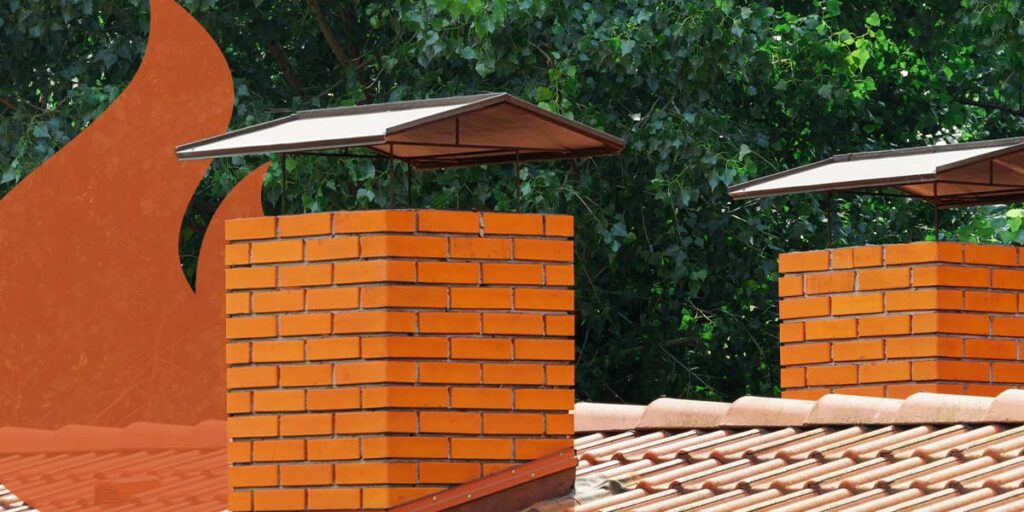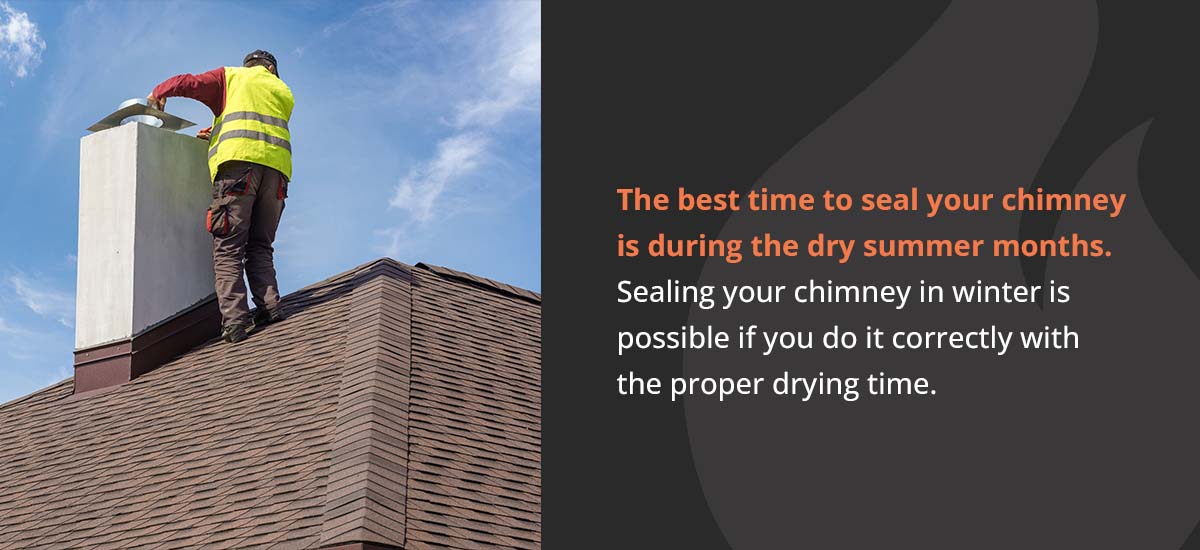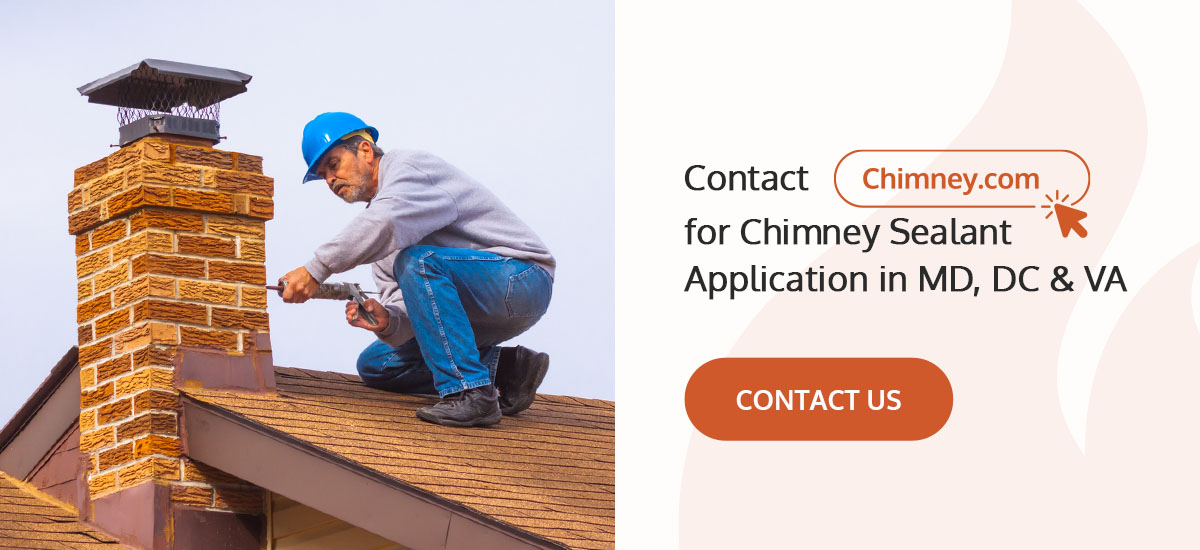Should You Use a Chimney Sealant?

01/19/24
Your home is in constant battle with moisture, which can penetrate building materials from both inside and out. Some parts of your home are more vulnerable than others. Because masonry chimneys are made from porous materials like brick and stone, they absorb moisture like a sponge. The best way to protect your chimney is to apply a waterproof sealant.
Why Is Moisture Problematic for Masonry Chimneys?
Keeping your chimney in tip-top shape involves maintenance, and that means keeping moisture out. If rain, humidity and condensation penetrate your masonry chimney, the bricks will deteriorate faster. This is due primarily to the freeze/thaw cycle, the same weathering process that causes asphalt roads to crack and develop potholes.
When water freezes inside a brick, the pores expand. Then, the water thaws and evaporates, leaving a larger space for water to fill next time. This process repeats over the winter months until the bricks lose their structural integrity, developing cracks and eventually loosening and falling out entirely.
What if Moisture Damage Has Already Occurred?
You may be considering using a chimney sealant because water damage has occurred in the past. However, it’s critical to address any existing moisture damage before applying a sealant. Otherwise, you could make the problem worse.
Here are the signs of water-damaged brickwork:
- Efflorescence: This white, powdery deposit appears when water saturates and then evaporates from unsealed masonry surfaces. Moisture transforms the salt inside the masonry into a soluble solution. Then, capillary action carries the salt to the brick’s surface, where the water evaporates and leaves crystallized salt deposits behind.
- Cracks: Cracked chimney bricks are never a good sign. The damage may be evidence that the bricks are deteriorating due to water intrusion.
- Spalling: Peeling, flaking bricks indicate that water has infiltrated the masonry material.
- Damaged mortar joints: Water doesn’t just damage chimney bricks — it can also deteriorate the mortar between them. Flaky mortar exposes more of the brick to water intrusion, accelerating the wear and tear.
- Loose or missing bricks: If broken bricks litter your yard, act quickly to repair the water damage, or the entire chimney could collapse.
How Does Sealant Protect Masonry Chimneys?
Sealing your chimney is one of the simplest, most affordable ways to prevent water from penetrating the bricks. Here’s why this form of chimney maintenance is so worthwhile:
- Prevent cracked bricks
- Reduce the risk of leaks
- Maintain the structural integrity of masonry materials
- Extend the life of your chimney
Should You Use Chimney Sealant? Factors to Consider
You should use a chimney sealant if your chimney is leaking and showing signs of water damage. Chimney sealants generally help, but remember to reapply the sealant as needed. Here are the factors you should keep in mind if you’re contemplating sealing your chimney:
1. Types of Chimney Sealant
Different types of sealants may work better for your chimney:
- Polyurethane: Polyurethane dries in 24 hours and remains tacky in that time. This sealant works best for wood, so it will not do well in sealing your chimney. It also dries very quickly when the temperatures are cold.
- Silicone sealant: This dries quickly and is suitable for synthetic materials. Silicone sealant is good for masonry chimneys due to the sealant’s inorganic substances. You can use this sealant in cold temperatures as it will dry slower. It may come out white but dries clear and is suitable for metal materials, too.
- Water-based sealants: A water-based sealant emits fewer chemical compounds when curing and is easier to clean. It’s also more breathable, which can benefit your chimney.
- Silane or siloxane sealers: These sealers work best on concrete surfaces like your masonry chimneys. The larger particles can seal the porous surfaces while the smaller ones can reinforce against extra moisture coming in.
Remember to choose a proper chimney sealant for your chimney. You may have compatibility issues if you select an unsuitable one. Consider the age, condition and type of chimney you have.
2. Cost and Longevity
A chimney sealant can keep your chimney waterproof for 15 to 20 years if you also perform proper maintenance on your chimney after sealing it up. You may need to seal your chimney several times after you seal it initially.
The main costs are for the sealant and tools to apply it. Other costs involved may include damage to your clothes, a new ladder if you don’t have one and a pair of utility gloves to protect your hands.
3. When to Apply Chimney Sealant

The best time to seal your chimney is during the dry summer months. Sealing your chimney in winter is possible if you do it correctly with the proper drying time. Remember to ensure your chimney is completely dry before using it again. Some sealants may also not work best when exposed to cold temperatures upon application.
4. Aftercare and Maintenance
Take these steps to ensure your newly sealed chimney remains in good working condition:
- Clean your chimney regularly: If you use your chimney, you should have it professionally cleaned. Lots of soot indicates that it’s time to clean your chimney.
- Examine your chimney: Check your chimney for damage and look for crumbling and missing bricks.
- Burn proper wood: Use dry wood gathered at least six months in advance to help reduce creosote buildup in your chimney.
- Use the correct burning method: Place larger logs at the bottom and smaller ones at the top to prevent loading up your chimney.
- Have a professional check your chimney annually: Checking your chimney once a year can help you spot minor problems and prevent them from turning into bigger ones.
5. Alternative Water Repellant Techniques
Ensuring your chimney is built well is the best way to repel water. However, you may be able to use other techniques to help repel moisture damage:
- Use waterproof paint: Paint the relevant areas of your chimney with waterproof paint to help mitigate water damage.
- Spray a water repellant: Use a spray nozzle to spray the top of your chimney.
- Add a chimney cap: You can also add a cap to the top of your chimney to keep out rainwater and moisture.
Should You Apply Chimney Sealant Yourself?
Several factors determine whether you should call a professional or apply sealant yourself. If your chimney has comprehensive damage, hiring a professional is best. Also, you may need different amounts of sealant for differing projects. So, how much sealant you will need is rarely straightforward.
Safety is another consideration you should pay attention to. You’ll need a ladder to seal your chimney correctly, and doing this alone can be dangerous. Proper ventilation is essential so you don’t inhale too many chemical fumes. Remember, you could inhale these fumes during the curing time, too. Getting sealer on your skin may also pose a health concern.
There’s also the risk of not preparing the surface correctly before you apply the sealant. This will affect whether the sealant holds and does an extensive job of keeping water out. Too much sealant could result in unsightly marks when dry.
Selecting & Applying a Chimney Sealant
The proper chimney sealant can protect against moisture intrusion for up to 15 to 20 years. The trick is to waterproof your chimney with vapor-permeable chimney sealant. This product protects the brick exterior from moisture while still allowing the pores to “breathe.”
Along with choosing the correct type of sealant, proper application is also crucial for achieving the best results. Leave the job to an experienced chimney repair technician who can professionally inspect, prepare, and seal your chimney.
Contact Chimney.com for Chimney Sealant Application in MD, DC & VA
Investing in regular chimney maintenance is the best way to prolong the life of your bricks and mortar and avoid more extensive chimney restoration. Chimney.com can perform all the repairs and maintenance tasks you need, including sealing your chimney. We use the appropriate sealant and check for water damage before proceeding. Then, we apply the sealant according to industry best practices to ensure superior results.
Contact us today or call (301) 989-3300 to work with a licensed, bonded and insured chimney repair company serving Maryland, Northern Virginia and Washington, DC.

